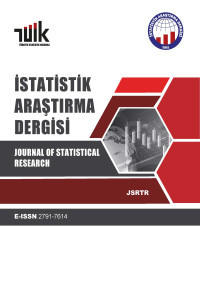Durağan Zaman Serilerinin Yapay Sinir Ağları ile Tahmininde Girdi Nöronu ve Gizli Nöron Sayısının Belirlenmesi
Bu çalışmada, yapay sinir ağlarının durağan zaman serileri ile geleceği tahminde performansını etkileyen girdi nöronu sayısı ve gizli nöron sayısı parametrelerinin en iyi değerinin belirlenmesi amacı ile bir deney tasarımı yapılmıştır. Ayrıca, Box-Jenkins modelleri ile yapay sinir ağı tekniğinin geleceği tahmindeki başarısı karşılaştırılmış hangi yöntemin daha iyi sonuç verdiği araştırılmıştır.
Anahtar Kelimeler:
Box-Jenkins Modelleri, Girdi Nöronu Sayısı, Gizli Nöron Sayısı Yapay Sinir Ağı
Determining Input and Hidden Neurons Numbers in Artificial Neural Networks for Forecasting Stationary Time Series
In this study, an experimental design has been conducted for determining the optimum values of input and hidden neurons numbers which are the factors affecting the performance of arrificial neural networks used to forecast stationary time series. Furthermore, results of Box-Jenkins models and artificial neural networks are compared and it is also investigated which method gives the better result.
Keywords:
Artificial Neural Networks Number of Input Neurons, Number of Hidden Neurons, Box Jenkins Models,
___
- BAILY, D. and THOMPSON, D. M. (1990). Devoloping Neural Network Applications, AI Expert, September, 33-41.
- BOX, G.P. and JENKINS, G.M. (1976). Time Series Analysis Forecasting and Control, San Francisco, Holden-Day.
- CYBENKO, G. (1989). Approximation by Superposition of a Sigmoidal Function, Mathematical Control Signal Systems, 2, 303-314.
- GHIASSI, M., SAIDANE, H., and ZİMBRA, D.K. (2004). A Dynamic Artificial Neural Network Model for Forecasting Time Series Events, International Journal of Forecasting, 21(2), 341-362.
- HİLL, T., MARQUEZ, L., O'CONNOR. M. and REMUS. W. (1994) Artificial Neural Networks for Forecasting and Decision Making, International Journal of Forecasting, 10, 5-15.
- HORNİK, K, STINCHCOMBE, M. and WHITE H. (1989), Multilayer Feed-Forward Networks are Universial Approximators, Neural Networks, 2, 359-366.
- HU. M.J.C. (1964), Application of the Adaline System to Weather Forecasting, Master Thesis, Technical Report 6775-1, Stanford Electronic Laboratories. Stanford.
- WARNG, H.B. and ANG. H.T. (2001). A Simple Neural Network for ARMA(p.q) Time Series Omega, 29, 319-333.
- KAASTRA, I and BOYD, M. (1996) Designing a Neural Network for Forecasting Financial and Econometric Time Series, Neurocomputing, 10, 215-236.
- KARTALOPOULOS, S.V. (1996), Understanding Neural Network and Fuzzy Logic, New York IEEE Pres.
- LAPADES, A and FARBER, R. (1987), Nonlinear Signal Processing Using Neural Networks: Prediction and System Modeling, Technical Report LA-UR-87-2662, Los Alamos National Laboratory, Los Alamos.
- LIPPMANN, R.P. (1987), an Introduction to Computing With Neural Nets, IEEE ASSP Magazine, April, 4-22.
- MARQUEZ, L., HILL, T., O'CONNOR, M. and REMUS, W. (1992), Neural Network Models for Forecast a Review, IEEE Proceedings of the 25th Hawaii Internatánal Conference on System Sciences, Hawaii, 4, 494-498.
- MASTERS, T. (1993), Practical Neural Network Recipes in C++, New York, Academic Press.
- RUMELHART. D.E., HINTON and G.E. WILLIAMS, R.J. (1986), Learning Internal Represantation by Back-Propagating Errors, The PDP Research Group, Paralel Distributed Processing: Explorations in the Microstructure of Cognition, Rumelhart, D.E. and McCleland, J.L., MA, MIT Pres.
- SEXTON, R.S., DORSEY, R.E, and SIKANDER, N.A. (2004), Simultaneous Optimization of Neural Network Function and Architecture Algortihm, Decision Support Systems, 36, 283-296.
- TANG, Z. and FISHWICK, P.A. (1993). Feedforward Neural Nets as Models for Time Series Forecasting, ORSA Journal on Computing, 5(4) 374-385.
- WONG, F.S. (1991). Time Series Forecasting Using Backpropagation Neural Networks Neurocomputing, 2, 147-159
- ZHANG, G. PATUWO, B.E. and HU MY. (1998). Forecasting with Artificial Neural Networks: The State of the Art, International Journal of Forecasting, 14, 35-62
- ZHANG, G. PATUWO, B.E., Hu, MY (2001), a Simulation Study of Artificial Neural Networks for Nonlinear Time Series Forecasting Computers & Operations Research. 28, 381-396
- ZHANG, G. (2003). Time Series Forecasting Using a Hybrid ARIMA and Neural Network Model, Neurocomputing, 50, 159-175.
- ISSN: 1303-6319
- Başlangıç: 2002
- Yayıncı: TÜİK
Sayıdaki Diğer Makaleler
Sıralı Küme Örneklemesinde Yardımcı Değişken Kullanılarak Yığın Ortalamasının Tahmini
